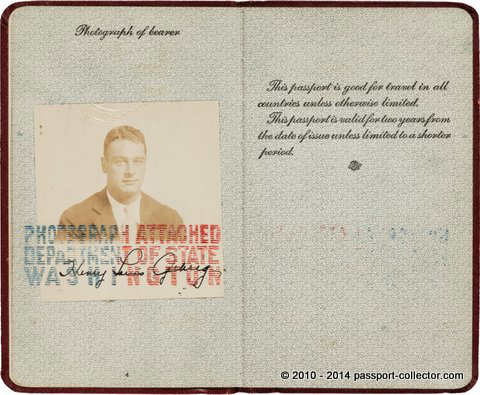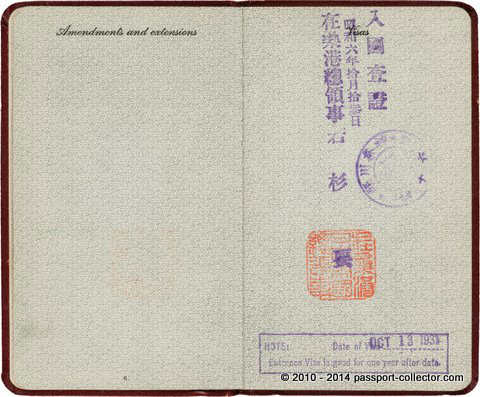Baseball: Lou Gehrig Passport for $263k
Baseball Lou Gehrig Passport
Here is the video “Passport Of Baseball Legend Lou Gehrig Sold For $263.000” of the auction I followed live online. I was already excited when the level was at $100.000 but the final result including buyers’ premium will be an incredible $263.000 I really didn’t expect. However, as I was tracking the document constantly I had the feeling it will mark a new record – and I was right. Enjoy his passport and the video… Baseball Lou Gehrig Passport
Henry Louis “Lou” or “Buster” Gehrig Baseball Legend Lou Gehrig
(June 19, 1903 – June 2, 1941) was an American baseball first baseman who played 17 seasons in Major League Baseball (MLB) for the New York Yankees (1923–1939). Gehrig was renowned for his prowess as a hitter and for his durability, a trait which earned him his nickname “The Iron Horse“. He finished with a career batting average of .340, an on-base percentage of .447, and a slugging percentage of .632, and he tallied 493 home runs and 1,995 runs batted in (RBIs). A seven-time All-Star and six-time World Series champion, Gehrig won the Triple Crown in 1934 and was twice named the American League’s (AL) Most Valuable Player. Gehrig was the first MLB player to have his uniform number retired, and he was elected to the Baseball Hall of Fame in 1939.
Baseball Lou Gehrig Passport

A native of New York City and attendee of Columbia University, Gehrig signed with the Yankees in 1923. He set several major league records during his career, including the most career grand slams (23) (since broken) and most consecutive games played (2,130), a record that stood for 56 years and was long considered unbreakable until surpassed by Cal Ripken, Jr. in 1995. Gehrig’s streak ended in 1939 after he was stricken with amyotrophic lateral sclerosis (ALS), a disorder now commonly referred to as Lou Gehrig’s Disease in North America, which forced him to retire at age 36 and claimed his life two years later. The pathos of his farewell from baseball was capped off by his iconic “Luckiest Man on the Face of the Earth” speech at the original Yankee Stadium. Baseball Lou Gehrig Passport
Gehrig was voted the greatest first baseman of all time by the Baseball Writers’ Association in 1969 and was the leading vote-getter on the Major League Baseball All-Century Team chosen by fans in 1999. A monument in Gehrig’s honor, originally dedicated by the Yankees in 1941, currently resides in Monument Park at Yankee Stadium. The Lou Gehrig Memorial Award, given annually to the MLB player best exhibiting the integrity and character of Gehrig, was named in the first baseman’s honor.
The passport Of Baseball Legend Lou Gehrig Sold For $263.000 and is now the most expensive travel document ever sold and is leading the list of celebrity passports followed by Marylin Monroe’s passport with a value of $115.000.


The leather-bound passport opens to reveal an inside front cover featuring personal details scripted in Gehrig’s flawless black fountain pen ink. The first and second of his three autographs appear here, each followed by the handwritten address of the New Rochelle home where the Yankee great lived and died. The former autograph appears in the rarest and most desirable format of all, a full “Henry Louis Gehrig.”
We turn the page to find Gehrig’s official data, listing his full name, date of passport issue, height, hair color, eye color, place and date of birth, and occupation of “Professional Ball Player.” The third and final autograph appears on the next page, a marvelous sepia-toned portrait photograph (3×3″) of the twenty-eight-year-old superstar again bearing the ideal “Henry Louis Gehrig” signature format. This signature, like the other two, is legitimately 10/10 in strength.


Just two border stamps appear within, marking Gehrig’s October 13, 1931 arrival in the Land of the Rising Sun, and his December 18 return to the United States. As noted in the text on the interior back cover, American passports at this time were effective for two years, requiring a newer model for his return to Japan in 1934. That passport, however, has never surfaced, leaving this as the sole survivor. Baseball Lou Gehrig Passport
FAQ Passport History
Passport collection, passport renewal, old passports for sale, vintage passport, emergency passport renewal, same day passport, passport application, pasaporte passeport паспорт 护照 パスポート جواز سفر पासपोर्ट
1. What are the earliest known examples of passports, and how have they evolved?
The word "passport" came up only in the mid 15th Century. Before that, such documents were safe conducts, recommendations or protection letters. On a practical aspect, the earliest passport I have seen was from the mid 16th Century. Read more...
2. Are there any notable historical figures or personalities whose passports are highly sought after by collectors?
Every collector is doing well to define his collection focus, and yes, there are collectors looking for Celebrity passports and travel documents of historical figures like Winston Churchill, Brothers Grimm, Johann Wolfgang von Goethe. Read more...
3. How did passport designs and security features change throughout different periods in history, and what impact did these changes have on forgery prevention?
"Passports" before the 18th Century had a pure functional character. Security features were, in the best case, a watermark and a wax seal. Forgery, back then, was not an issue like it is nowadays. Only from the 1980s on, security features became a thing. A state-of-the-art passport nowadays has dozens of security features - visible and invisible. Some are known only by the security document printer itself. Read more...
4. What are some of the rarest and most valuable historical passports that have ever been sold or auctioned?
Lou Gehrig, Victor Tsoi, Marilyn Monroe, James Joyce, and Albert Einstein when it comes to the most expensive ones. Read more...
5. How do diplomatic passports differ from regular passports, and what makes them significant to collectors?
Such documents were often held by officials in high ranks, like ambassadors, consuls or special envoys. Furthermore, these travel documents are often frequently traveled. Hence, they hold a tapestry of stamps or visas. Partly from unusual places.
6. Can you provide insights into the stories behind specific historical passports that offer unique insights into past travel and migration trends?
A passport tells the story of its bearer and these stories can be everything - surprising, sad, vivid. Isabella Bird and her travels (1831-1904) or Mary Kingsley, a fearless Lady explorer.
7. What role did passports play during significant historical events, such as wartime travel restrictions or international treaties?
During war, a passport could have been a matter of life or death. Especially, when we are looking into WWII and the Holocaust. And yes, during that time, passports and similar documents were often forged to escape and save lives. Example...
8. How has the emergence of digital passports and biometric identification impacted the world of passport collecting?
Current modern passports having now often a sparkling, flashy design. This has mainly two reasons. 1. Improved security and 2. Displaying a countries' heritage, icons, and important figures or achievements. I can fully understand that those modern documents are wanted, especially by younger collectors.
9. Are there any specialized collections of passports, such as those from a specific country, era, or distinguished individuals?
Yes, the University of Western Sidney Library has e.g. a passport collection of the former prime minister Hon Edward Gough Whitlam and his wife Margaret. They are all diplomatic passports and I had the pleasure to apprise them. I hold e.g. a collection of almost all types of the German Empire passports (only 2 types are still missing). Also, my East German passport collection is quite extensive with pretty rare passport types.
10. Where can passport collectors find reliable resources and reputable sellers to expand their collection and learn more about passport history?
A good start is eBay, Delcampe, flea markets, garage or estate sales. The more significant travel documents you probably find at the classic auction houses. Sometimes I also offer documents from my archive/collection. See offers... As you are already here, you surely found a great source on the topic 😉
Other great sources are: Scottish Passports, The Nansen passport, The secret lives of diplomatic couriers
11. Is vintage passport collecting legal? What are the regulations and considerations collectors should know when acquiring historical passports?
First, it's important to stress that each country has its own laws when it comes to passports. Collecting old vintage passports for historical or educational reasons is safe and legal, or at least tolerated. More details on the legal aspects are here...
Does this article spark your curiosity about passport collecting and the history of passports? With this valuable information, you have a good basis to start your own passport collection.
Question? Contact me...

